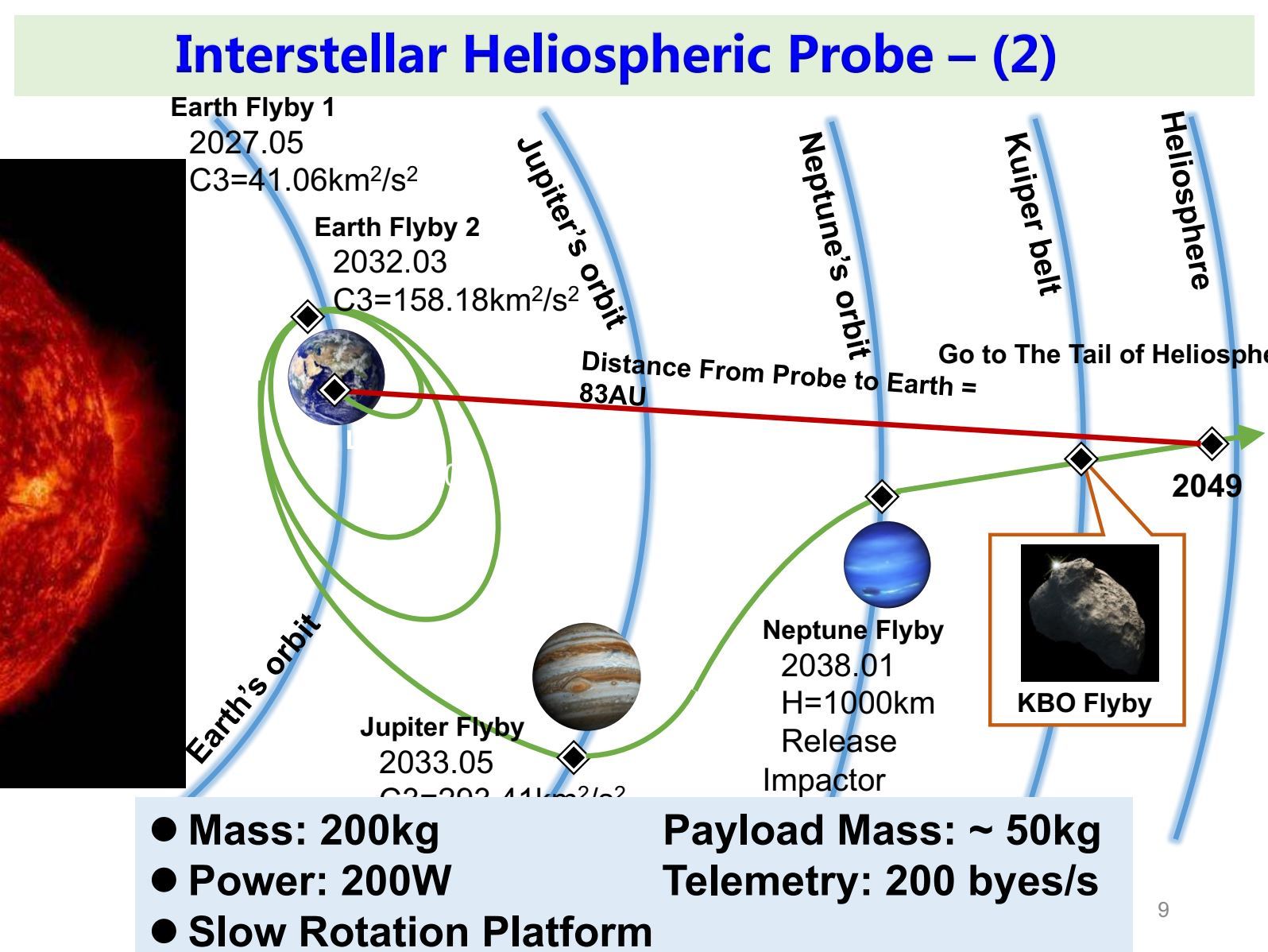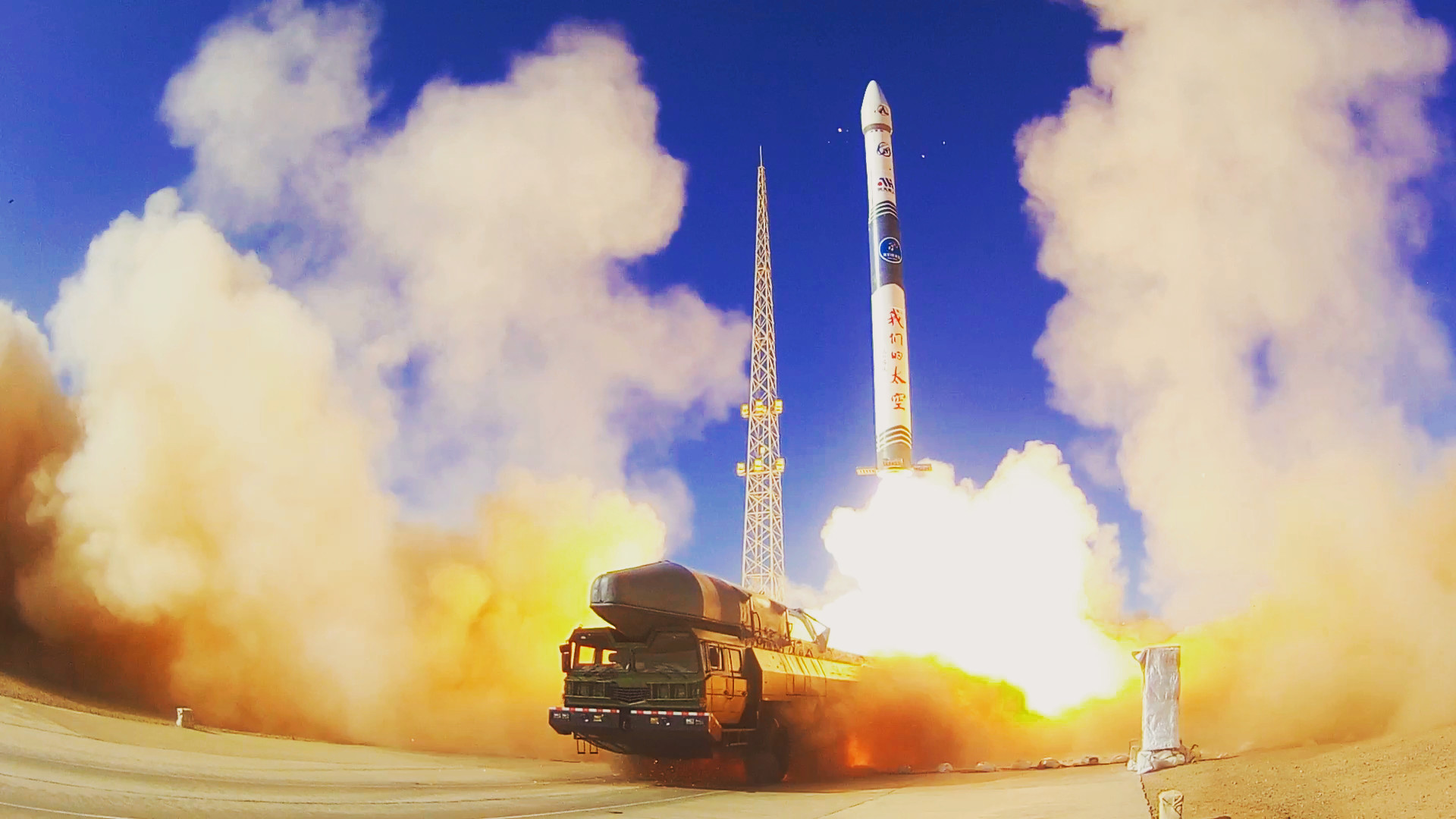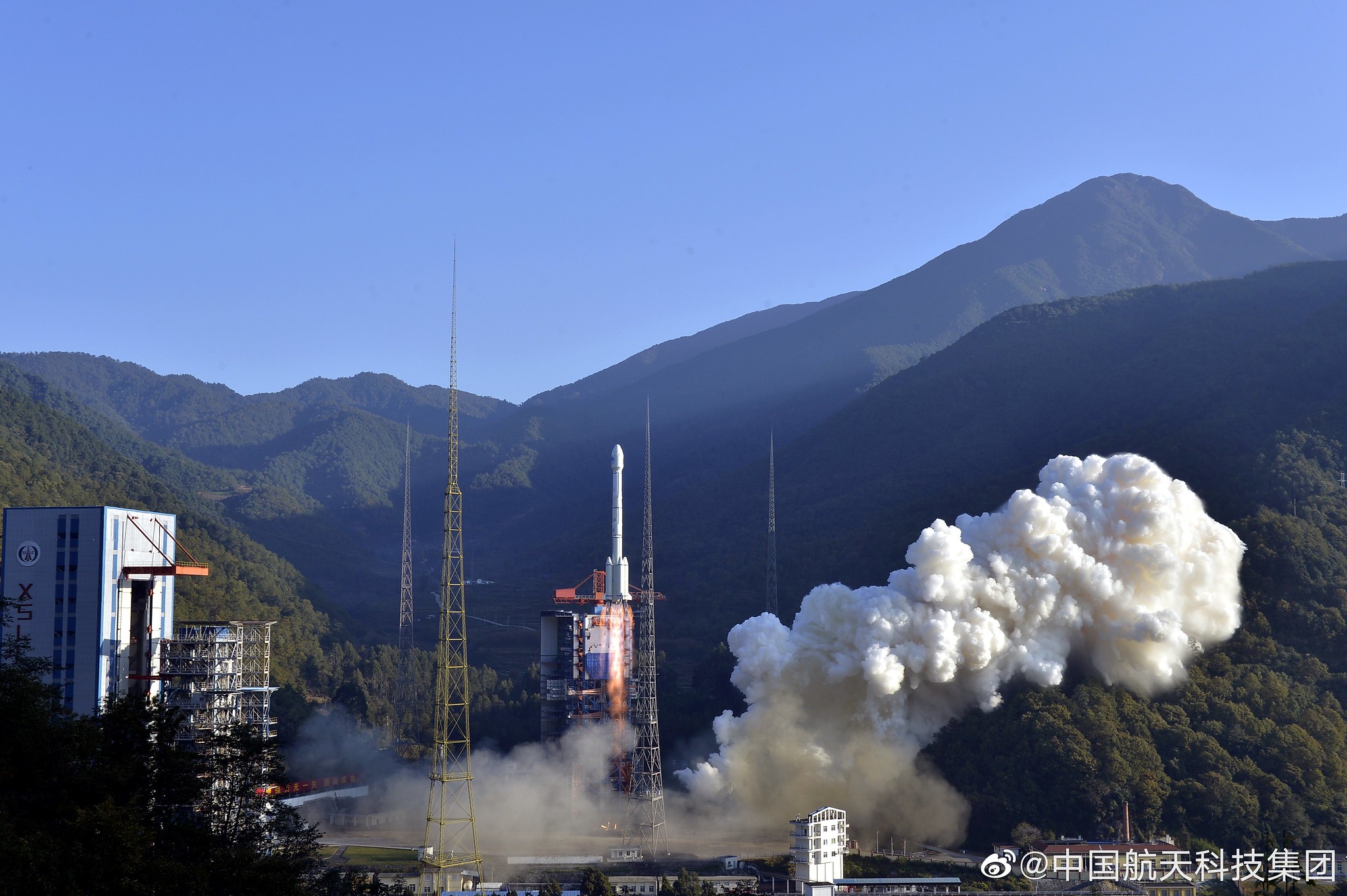You are using an out of date browser. It may not display this or other websites correctly.
You should upgrade or use an alternative browser.
You should upgrade or use an alternative browser.
China's Space Program News Thread
- Thread starter crazyinsane105
- Start date
- Status
- Not open for further replies.
Two global multimedia satellites, KL-a-A and KL-a-B, are launched by a Kuaizhou-1A (KZ-1A) carrier rocket from the Jiuquan Satellite Launch Center in Jiuquan, northwest China's Gansu Province, Nov. 17, 2019. (Photo/Ma Chongpeng)
China Satcom has filed an insurance claim for the loss of the ChinaSat-18 communications satellite after failing to establish contact with the spacecraft.
A claim for ChinaSat-18, which SpaceNews previously reported was insured for $250 million, has been long expected.
The ChinaSat-18 communications satellite was Aug. 19 atop a Long March 3B launch vehicle from the Xichang Satellite Launch Center. Yet no contact was established with the satellite following separation.
A Nov.19 announcement (Chinese, ) to the Shanghai Stock Exchange noted that the launch was successful and the satellite separated from the launch vehicle normally. However attempts to communicate with the satellite were unsuccessful. According to an investigation by the satellite manufacturer the satellite suffered a complete power failure.
ChinaSat-18 remains in a geostationary transfer orbit instead of the intended circularized geosynchronous orbit, according to data from Space-Track.
Rescue attempts have, up to the present, failed, leading to the insurance claim. Even if communication with the satellite is established it will not have normal communication capabilities.
I wonder if the launch insurance works in China like it does in the US.


China is planning a Voyager-like mission to the outer solar system that includes a flyby of Neptune, measurements of the electrically charged gas bubble surrounding our solar system, and a journey to interstellar space.
The mission is currently named IHP, which stands for Interstellar Heliosphere Probe. It consists of two spacecraft that would explore the heliosphere, the solar-wind-created region around our Sun that separates us from interstellar space as the solar system travels through the Milky Way.
Zong Qiugang, the director of the Institute of Space Physics and Applied Technology at Peking University in China, said the mission “will allow us to discover, explore, and understand fundamental astrophysical processes in the largest plasma laboratory—the heliosphere.” at EPSC-DPS 2019, an international gathering of planetary scientists in Geneva, Switzerland.
The first spacecraft, IHP-1, would launch towards the head of the heliosphere in 2024. A second probe, IHP-2, would go in the opposite direction to explore the tail. The heliosphere is hypothesized to resemble a comet’s tail, but is an open question. The Voyagers exited the heliosphere on the head side, and the tail has never been explored.
The link is CNSA (China National Space Agency). It is in Chinese, but it is accessible from Europe. Anyway, if you read Chinese here it is
I am not sure if I understand the rest of your comment though. So I will just repeat what I believe. This CBC manned rocket is not experimental, it will turn out to be a full launcher with some tuning. The thing is that there was NEVER an experimental launcher in China's history, as far as I am aware. It seems to me that China does a long and through pre-study of various configurations on paper and in calculation, together with component research, then decide on ONLY one design to be produced. It is the same as the 4th gen fighter jet, J-20 is the only one made in full development, other competing options never left drawing board. This approach is very different from the US, of course.
As a side note, there is a report about 8th academy in Shanghai just made a 3.8m tank if I remember correctly. People are speculating that it is 8th academy's competing design for the new manned launcher. It is speculated to be 5 CBC 1st stage. If it is true that it is a competing design, it will be the first time in Chinese rocketry history to have physical prototype competition. BUT I highly doubt this is the case because unlike this 5m CBC being shown in CASC's presentation and official report, this supposed competing design has never went public and remained as speculation by netizens.
So, about the "CZ-FH" rocket, I just found this article from Xinhua last year, which talks about a 2000 ton/25 ton LTO rocket (obviously the same rocket concept that's emerged to be in development), being capable of VTVL reuse by virtue of its configuration, stated by Wang Xiao Jun of CALT
Specifically this part: "并且采用多台发动机并联布局可以实现垂直起降重复使用"
So it seems like this is strong indication that the new rocket is being designed with VTVL reuse in mind at some stage. Watch this space to consider if we see models of this rocket with landing legs in due time -- if we see that, then of course it would be even stronger suggestion or even confirmation that they are planning for it.
But for now, the xinhua article quoting Wang XiaoJun is surprisingly authoritative.
Full article posted so we have a record.
新一代载人运载火箭载人飞船研制已取得阶段性成果
我要评论
2018年11月06日 16:52:31 来源: 新华社
新华社广州11月6日电(记者陈芳、胡喆)起飞重量约2000吨、可与重型运载火箭组合使用建立月球基地……记者从11月6日在珠海开幕的第12届中国国际航空航天博览会上了解到,我国已启动新一代载人运载火箭和载人飞船研制工作,目前已取得阶段性成果。
新一代载人运载火箭是根据我国载人航天工程发展规划,为发射我国新一代载人飞船而全新研制的高可靠、高安全的载人火箭。中国航天科技集团一院长征七号运载火箭总指挥王小军说,新一代载人运载火箭将按照载人飞行的最高安全标准进行设计,在近期可以用于载人月球探测工程中的环月、绕月等演示验证任务,快速推动我国运载火箭技术和进出空间能力的重大提升和跨越。未来还可以和长征九号运载火箭组合使用建立月球基地,实现月球可持续开发利用。
据王小军介绍,新一代载人火箭起飞重量约2000吨,可以将25吨有效载荷直接送入奔月轨道,或者将70吨有效载荷送入近地轨道,还可以与多种模块组合使用,形成近地轨道40吨至70吨,地球同步轨道10吨至32吨的系列化型谱,并且采用多台发动机并联布局可以实现垂直起降重复使用。火箭研制工作已在近期完成了新型泵后摆高压补燃发动机、固体可调推力姿控发动机等的点火试车。
据中国航天科技集团介绍,新一代载人飞船是面向我国载人航天未来发展需求而论证的新一代载人天地往返运输飞行器,飞船采用返回舱与服务舱两舱构型,全长约9米,最大发射重量23吨,在充分继承我国载人航天工程已有技术的基础上,在结构、推进、回收、能源、热控、电子、人机交互和可重复使用等方面采用了一系列先进技术,使飞船具备高可靠、高安全、低成本和宜居的特点。飞船采用模块化设计,可适应近地轨道飞行、载人月球探测和载人深空探测等多种任务。
A different article from not state media, but from similar time last year and making similar statement about VTVL reusability
"同时其采用多台发动机并联布局,可以实现垂直起降重复使用"
喜讯!我国新一代载人火箭就要来了!
来源:科技日报微信公号 作者: 2018-11-06 17:33:11
记者5日从中国航天科技集团一院获悉,我国已启动新一代载人运载火箭预研工作,目前关键技术已取得阶段性成功。该火箭将在6日开幕的第十二届中国国际航空航天博览会上首次亮相。
新一代载人运载火箭是根据我国载人航天工程发展规划,为发射我国新一代载人飞船而全新研制。据一院长征七号系列运载火箭总指挥王小军介绍,该火箭按照载人飞行的最高安全标准设计,火箭未来可用于载人月球探测,将快速推动我国运载火箭技术和进出空间能力的重大提升和跨越。在更远的将来还可以和重型运载火箭组合使用,建立月球基地,实现月球可持续开发利用。
一院运载火箭专家胡晓军在航天科技集团近日举行的通气会上透露,新一代载人火箭直径5米、全长约90米、起飞重量约2000吨,可以将25吨有效载荷直接送入奔月轨道,或者将70吨有效载荷送入近地轨道。同时其采用多台发动机并联布局,可以实现垂直起降重复使用。
“三高三新”六大特点
“新一代载人运载火箭具有高效率、高可靠、高安全以及新材料、新结构、新模式的‘三高三新’特点。”胡晓军说。
胡晓军介绍,该火箭采用新设计方法和系统设计方案,通过综合优化实现运载效率较现有火箭提高10%至30%;继承现有火箭成熟的发动机技术以及冗余技术,采用基于故障设计的发动机冗余和控制重构技术,提高系统固有可靠性;逃逸姿态控制由无控改进为闭环控制,逃逸模式简化为一种,提高航天员的安全性。实现推进剂加注泄出无人值守,提高操作安全性。
同时,该火箭采用与液氧相容的复合材料冷氦增压气瓶、复合材料壳段、高性能铝合金等先进材料,降低结构重量;采用贮箱后底与机架一体化设计、箱底传力设计、5米大直径低温共底贮箱、大直径横向分离级间段等新结构形式,大幅提升全箭结构效率;采用一体化电气系统,应用综合电子、部段级自主测试技术,提高集成化水平,简化测试操作。
预计2019年完成关键技术攻关
2016年,一院按照立足成熟技术、确保安全可靠,能力上台阶、技术上水平的发展要求,对标世界一流运载火箭,启动了新一代载人运载火箭方案论证工作。目前已完成了多轮方案对比分析,正在开展关键技术深化论证。
胡晓军说,研制团队已经攻克泵后摆发动机、高压补燃发动机低压起动、固体发动机推力调节、新型无毒姿态控制发动机温起动、轻质伺服机构等多项关键技术,目前正在开展大直径低温共底贮箱、超低温复合材料气瓶、千吨级轻质箭体结构等原理样机的研制生产,预计2019年完成关键技术攻关。
记者了解到,近期该火箭已完成新型泵后摆高压补燃发动机、固体可调推力姿控发动机、新型无毒姿控发动机的点火试车。胡晓军介绍,后续一院将根据载人航天高可靠高安全的技术要求,按照“充分试验、逐步验证”发展思路,先后开展逃逸飞行验证、芯一级飞行演示验证、两级状态飞行演示验证、全箭飞行验证等工作,确保载人火箭安全可靠,载人飞行万无一失。
将推动我国航天强国建设进程
“新一代载人运载火箭的研制,将进一步推动我国航天强国建设进程。”胡晓军说。
胡晓军表示,首先,该火箭将采用模块化组合,形成一个系列,两种构型;基于故障设计,实现动力冗余与控制重构、逃逸闭环控制、推进剂无毒无污染、加注泄出无人值守,满足我国载人火箭高可靠高安全要求。第二,该火箭最大程度发挥了我国现有运载火箭研制能力体系,通过充分利用现有模块、优化组合,其运载效率可达到国际先进水平,将大幅提升我国进出空间的能力。同时,该火箭瞄准国际先进技术趋势,采用飞行在线规划控制、固体可调推力发动机、无毒姿控发动机为代表的新技术,使用轻质高强铝合金、低温复合材料为代表的新材料,并应用3D打印、大直径箱底整体成形等新工艺,推动了技术的更新换代。
此外,新一代载人运载火箭打破传统研制模式,采用一体化协同设计、数字虚拟试验等先进研制手段,通过集成演示试验部分替代传统复杂的单项试验,可大幅缩短研制周期、提升研制效率,推动研制模式创新。
The Xinhua report is about the same rocket from an event held in Zhuhai August 2018. The same rocket showed up in another event in October 2018 in Xi'an. Here is the slide.So, about the "CZ-FH" rocket, I just found this article from Xinhua last year, which talks about a 2000 ton/25 ton LTO rocket (obviously the same rocket concept that's emerged to be in development), being capable of VTVL reuse by virtue of its configuration, stated by Wang Xiao Jun of CALT
Specifically this part: "并且采用多台发动机并联布局可以实现垂直起降重复使用"
So it seems like this is strong indication that the new rocket is being designed with VTVL reuse in mind at some stage. Watch this space to consider if we see models of this rocket with landing legs in due time -- if we see that, then of course it would be even stronger suggestion or even confirmation that they are planning for it.
But for now, the xinhua article quoting Wang XiaoJun is surprisingly authoritative.
Full article posted so we have a record.
新一代载人运载火箭载人飞船研制已取得阶段性成果
我要评论
2018年11月06日 16:52:31 来源: 新华社
新华社广州11月6日电(记者陈芳、胡喆)起飞重量约2000吨、可与重型运载火箭组合使用建立月球基地……记者从11月6日在珠海开幕的第12届中国国际航空航天博览会上了解到,我国已启动新一代载人运载火箭和载人飞船研制工作,目前已取得阶段性成果。
新一代载人运载火箭是根据我国载人航天工程发展规划,为发射我国新一代载人飞船而全新研制的高可靠、高安全的载人火箭。中国航天科技集团一院长征七号运载火箭总指挥王小军说,新一代载人运载火箭将按照载人飞行的最高安全标准进行设计,在近期可以用于载人月球探测工程中的环月、绕月等演示验证任务,快速推动我国运载火箭技术和进出空间能力的重大提升和跨越。未来还可以和长征九号运载火箭组合使用建立月球基地,实现月球可持续开发利用。
据王小军介绍,新一代载人火箭起飞重量约2000吨,可以将25吨有效载荷直接送入奔月轨道,或者将70吨有效载荷送入近地轨道,还可以与多种模块组合使用,形成近地轨道40吨至70吨,地球同步轨道10吨至32吨的系列化型谱,并且采用多台发动机并联布局可以实现垂直起降重复使用。火箭研制工作已在近期完成了新型泵后摆高压补燃发动机、固体可调推力姿控发动机等的点火试车。
据中国航天科技集团介绍,新一代载人飞船是面向我国载人航天未来发展需求而论证的新一代载人天地往返运输飞行器,飞船采用返回舱与服务舱两舱构型,全长约9米,最大发射重量23吨,在充分继承我国载人航天工程已有技术的基础上,在结构、推进、回收、能源、热控、电子、人机交互和可重复使用等方面采用了一系列先进技术,使飞船具备高可靠、高安全、低成本和宜居的特点。飞船采用模块化设计,可适应近地轨道飞行、载人月球探测和载人深空探测等多种任务。
A different article from not state media, but from similar time last year and making similar statement about VTVL reusability
"同时其采用多台发动机并联布局,可以实现垂直起降重复使用"
喜讯!我国新一代载人火箭就要来了!
来源:科技日报微信公号 作者: 2018-11-06 17:33:11
记者5日从中国航天科技集团一院获悉,我国已启动新一代载人运载火箭预研工作,目前关键技术已取得阶段性成功。该火箭将在6日开幕的第十二届中国国际航空航天博览会上首次亮相。
新一代载人运载火箭是根据我国载人航天工程发展规划,为发射我国新一代载人飞船而全新研制。据一院长征七号系列运载火箭总指挥王小军介绍,该火箭按照载人飞行的最高安全标准设计,火箭未来可用于载人月球探测,将快速推动我国运载火箭技术和进出空间能力的重大提升和跨越。在更远的将来还可以和重型运载火箭组合使用,建立月球基地,实现月球可持续开发利用。
一院运载火箭专家胡晓军在航天科技集团近日举行的通气会上透露,新一代载人火箭直径5米、全长约90米、起飞重量约2000吨,可以将25吨有效载荷直接送入奔月轨道,或者将70吨有效载荷送入近地轨道。同时其采用多台发动机并联布局,可以实现垂直起降重复使用。
“三高三新”六大特点
“新一代载人运载火箭具有高效率、高可靠、高安全以及新材料、新结构、新模式的‘三高三新’特点。”胡晓军说。
胡晓军介绍,该火箭采用新设计方法和系统设计方案,通过综合优化实现运载效率较现有火箭提高10%至30%;继承现有火箭成熟的发动机技术以及冗余技术,采用基于故障设计的发动机冗余和控制重构技术,提高系统固有可靠性;逃逸姿态控制由无控改进为闭环控制,逃逸模式简化为一种,提高航天员的安全性。实现推进剂加注泄出无人值守,提高操作安全性。
同时,该火箭采用与液氧相容的复合材料冷氦增压气瓶、复合材料壳段、高性能铝合金等先进材料,降低结构重量;采用贮箱后底与机架一体化设计、箱底传力设计、5米大直径低温共底贮箱、大直径横向分离级间段等新结构形式,大幅提升全箭结构效率;采用一体化电气系统,应用综合电子、部段级自主测试技术,提高集成化水平,简化测试操作。
预计2019年完成关键技术攻关
2016年,一院按照立足成熟技术、确保安全可靠,能力上台阶、技术上水平的发展要求,对标世界一流运载火箭,启动了新一代载人运载火箭方案论证工作。目前已完成了多轮方案对比分析,正在开展关键技术深化论证。
胡晓军说,研制团队已经攻克泵后摆发动机、高压补燃发动机低压起动、固体发动机推力调节、新型无毒姿态控制发动机温起动、轻质伺服机构等多项关键技术,目前正在开展大直径低温共底贮箱、超低温复合材料气瓶、千吨级轻质箭体结构等原理样机的研制生产,预计2019年完成关键技术攻关。
记者了解到,近期该火箭已完成新型泵后摆高压补燃发动机、固体可调推力姿控发动机、新型无毒姿控发动机的点火试车。胡晓军介绍,后续一院将根据载人航天高可靠高安全的技术要求,按照“充分试验、逐步验证”发展思路,先后开展逃逸飞行验证、芯一级飞行演示验证、两级状态飞行演示验证、全箭飞行验证等工作,确保载人火箭安全可靠,载人飞行万无一失。
将推动我国航天强国建设进程
“新一代载人运载火箭的研制,将进一步推动我国航天强国建设进程。”胡晓军说。
胡晓军表示,首先,该火箭将采用模块化组合,形成一个系列,两种构型;基于故障设计,实现动力冗余与控制重构、逃逸闭环控制、推进剂无毒无污染、加注泄出无人值守,满足我国载人火箭高可靠高安全要求。第二,该火箭最大程度发挥了我国现有运载火箭研制能力体系,通过充分利用现有模块、优化组合,其运载效率可达到国际先进水平,将大幅提升我国进出空间的能力。同时,该火箭瞄准国际先进技术趋势,采用飞行在线规划控制、固体可调推力发动机、无毒姿控发动机为代表的新技术,使用轻质高强铝合金、低温复合材料为代表的新材料,并应用3D打印、大直径箱底整体成形等新工艺,推动了技术的更新换代。
此外,新一代载人运载火箭打破传统研制模式,采用一体化协同设计、数字虚拟试验等先进研制手段,通过集成演示试验部分替代传统复杂的单项试验,可大幅缩短研制周期、提升研制效率,推动研制模式创新。

Indeed this specific rocket (921, 3CBC or as you call it CZ-FH) has VTVL design in mind, not necessarily in its initial launches, but certainly over its course of development. The first stage engine being YF-100K has been ground tested in variable thrust between 65% and 105% in at least two tests. As a reference, Merlin D is 70% to 100%. Here are the results from a paper published in 2018

When we talk about VTVL, we will have to use Falcon as benchmark. Falcon's ability of VTVL is achieved by Merlin D's throttle of thrust from 100% to 70% (same as YF-100K), however that throttling range is far from adequate. The mass of a launcher first stage is about 10% (even lower in Falcon) of its liftoff mass, that dictate about 10% (preferably slightly lower than mass) thrust at landing. This is also why China is developing an improved YF-100 to 10% thrust (same paper of the diagram above).
Falcon 9 realizes VTVL by shutting down 8 of its 9 engines, that gives about 11%, but 11% will still be too much thrust than mass, especially when Falcon is very light (good for launching load bad for landing). So, the last engine must throttle down to 70%. The same goes with FH, 3 left, 24 shut down. The earlier failure of Falcon landing was apparently due to executive thrust (unable to throttle down enough) compared to too empty tank.
The 921 has 3x7 YF-100K at the first stage. IF China goes SpaceX way, I don't believe they will though, 1 out of 7 will be running at landing, that is 14.2% at 100% thrust. at 65% throttled thrust, it will be 9.3%, which is perfect for VTVL. So if China really want to join a "size" competition, China can already done so. In reality, I believe China has chosen NOT to go that way by shutting down any engine, but to throttle down all of them to 10% at landing when the ongoing improvement of YF-100 is concluded.
The reason are two folds, firstly VTVL is not the priority for China, the priority is the reliability of manned mission to the moon and earth orbit. Secondly, shutting down 1 of 7 (1 of 9 in Falcon) is very risky than gradually throttling down the thrust of all, a split of second delay of one engine over others will create imbalance, therefor risking of tipping over the rocket, the recent Indian failure of moon lander is a good example. SpaceX has managed to do so successfully does not mean the risk is not there and it will remain there forever, it is better to get rid of once for all.
On a separate track, the first Chinese VTVL will be the CZ-8A to be launched in 2021 according to Long Lehao's presentation in 2018. It is a 3.5m core (2xYF100K) and two 2.5m strapons (1xYF100K) landing as a bundle. This configuration is however a sort of SpaceX approach, the engines in the core will be shutdown at landing.
The key to remember is that it is the engine's deep throttling capability the dictating factor of VTVL, once we have it, in theory any rocket can be VTVL, CBC or single stick.
A successful Chinese Long March 3B launch of a pair of Beidou satellites Friday had severe consequences downrange with a spent stage destroying a home.
A Long March 3B lifted off from the Xichang Satellite Launch Center at 7:55 p.m. Eastern Friday, with a Yuanzheng-1 upper delivering two Beidou satellites into medium Earth orbit.
The Beidou-3 M21 and M22 satellites have been cataloged in orbits with an average altitude of 21,800 kilometers and inclined by 55 degrees by Space-track.
The mission was China’s 28th orbital attempt of 2019 but the launch attracted attention for its impact back on Earth.
Video footage emerged on shortly after launch showing the apparent destruction of a rural building. Flames are seen within the building along with fumes from residual propellant rising from the booster wreckage.
- Status
- Not open for further replies.







